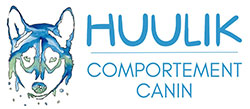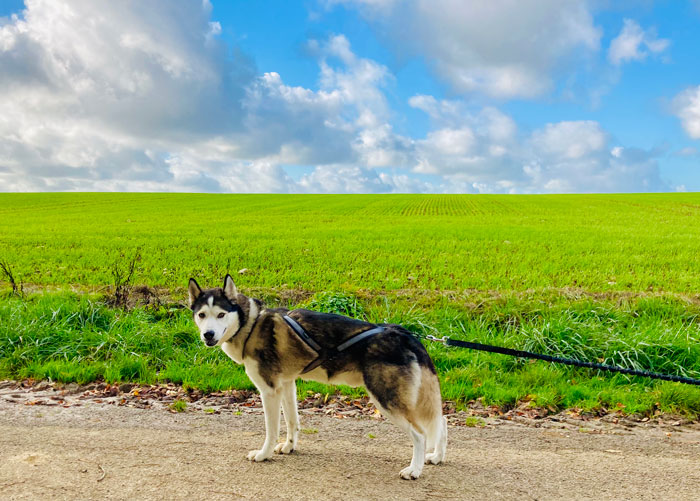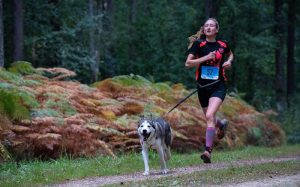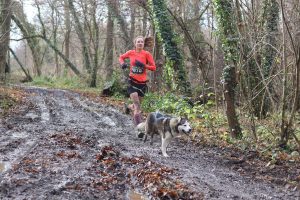You practice canicross and your dog is motivated, even excited at the start. But you would like him to be calm until the countdown because you have difficulty holding him… He deafens you, your arms ache as much as your legs? And above all, he gets hot and tired even before the race starts, or even shows undesirable behaviors due to excitement? Find out how to teach your dog to be calm at the start of a canicross.
Indeed, it is very interesting to have a dog, two dogs, and even a whole team, calm on the starting line, waiting for the cue to start. No noise, no barking, no howling, no jumping around, no dogs getting hot before the event starts. And yet, the majority of dogs do not behave in this way. You only have to go to a canicross training or competition to feel the atmosphere at the start.
You may have heard that in order to teach your dog to be calm at the start of a canicross, you should not take the start until the dog is calm. This advice is regularly repeated in canicross, caniVTT, cani scooter and mushing competitions.
It is indeed something to put in place, but it will not work for all dogs. In any case, it will not be enough for some. It may even make the dog’s behavior worse in the first place. Why? If your dog is aroused, excited to go running, making him wait may actually make him more excited, and even frustrated. And some dogs don’t handle frustration well. Your dog will not be able to calm down because he will only have one thing on his mind: running. Moreover, your dog has to know what you expect from him at that moment, otherwise, he cannot even try!
Indeed, if you are used to leave with an excited dog, if you don’t set up any training or any new routine, which would allow you to reward your dog for his “good” behavior, i.e. the one you expect: calmness… how could your dog guess what you expect from him?
Canicross: how to have a calm dog at the start?
So how do I get my dog to be calm at the start of a canicross race? First of all, we have to put our dog -and ourselves- in a situation of success! This also implies to avoid situations where our dog would be in high difficulty. We will thus anticipate. We are going to avoid situations in which the undesirable behavior is likely to occur, as long as our dog is not capable of handling these situations. At the same time, we will work specifically on the behavior we want to obtain. This will give us plenty of opportunities to reward our dog for the desired behavior: calmness at the start.
Calm at the start of a canicross: defining our goal
First of all, we must define a precise goal, in order to be consistent in our training. Our final goal is to learn calmness at the start of a canicross. It could be described precisely as follows: at the start of a canicross/caniVTT/etc training or race, my dog remains standing, motionless and silent in front of me, with the canicross leash extended, until I give him a start signal which is a signal of your choice, for example “Ok”, or “Go”.
Having a calm dog at the start of a canicross: breaking down the final goal into steps
Once our goal is clearly defined, we will break it down into intermediate goals, which we will work on. This will allow us to make each goal understandable and achievable for our dog and ourselves, and thus to teach calmness at the start of canicross.
If you are just starting canicross, you will be able to start right away on a good basis!
You can check here for general tips on canicross.
Canicross: my dog gets excited at the start, how to react
If you already practice canicross or traction sports in general, and your dog gets excited at the start, here is how to proceed.
First, don’t ask too much of your dog! If your dog shows a few seconds of calm before becoming excited, take advantage of this moment and take the start! Taking the start, for a dog who is excited and motivated to run, is a reward. We will therefore allow him to start when he is calm, and thus reward him for his behavior. This will give us time to work on calmness in parallel. Of course this is only possible in training… but isn’t it one of the roles of training in canicross?!
This will prevent us from starting out with an excited dog, and avoid our dog performing undesirable behaviors (barking, jumping, howling, etc). This is a good thing since we want to avoid reinforcing them. At the same time, we will avoid frustrating him and increasing his excitement.
Teaching the canicross starts
Instead of focusing on what we don’t want, we will focus on learning the behavior we would like to obtain. This will allow us to ask our dog for this alternative behavior. Indeed, teaching our dog to be calm at the start of a canicross means that we have to make him understand what we want from him!
The wanted position
One of the key elements on the start is to have your dog in the “right” position. That is, a position that is comfortable for both of you to start. What is that position? In general, we prefer to have a dog standing in front of us, motionless, with the lead extended. Why do we prefer this? Because it allows us to take the start alone, without a handler in bikejoring or dog scooter. Indeed, the dog does not risk to get tangled, to escape his harness, to go to see his friends, etc. It also allows to start without the dog suffering a blow in the back when he puts the line under tension, as he would get if we started with the line relaxed.
In canicross, you can use your arm to hold the line and act as an additional shock absorber at the start and control your dog better. However, in bikejoring, or dog scooter, this is not possible. Therefore, we usually ask a handler to hold the dog in front of the bike for example, with the line stretched. However, if you don’t have the luxury of having a handler, for example when training, it is more complicated to preserve the back of your dog. And even for a handler, it’s much more comfortable to watch a calm dog than to have to hold a kangaroo (there already have been broken noses on races…!).
How to get the starting position for canicross?
Always start the exercises in the easiest conditions for your dog, i.e. with as few distractions as possible. In general, this is best done in the house, with no other dogs around, and with no one else in the room but you and your dog.
In order for your dog to be able to stand in front of you, without moving, you will have to work progressively. We will start with a position in which the dog is less likely to move, to set the conditions for success. Choose “sit” or “down”, whichever is easier for your dog.
Ask your dog for this position. Mark with your voice (with your usual marker, such as “yes”) and reward with a treat. Take a small step away from your dog. Mark and reward your dog for not moving by giving him the treat. Leave your dog in position and repeat. Gradually increase the distance you put between you and your dog. When you want to finish the exercise, release your dog from the position by throwing a reward forward, combined with a cue of your choice, such as “ok”, or “go”. Keep the sessions very short, 2 to 5 minutes. You can repeat the exercise several times a day.
Getting into the right positions
Eventually, we try to get behind our dog. This is usually more difficult because our dog will not see us, and he may tend to stand up and turn around to look at us, rather than just turning his head towards us and holding his position. So we will perform the exercise by moving away little by little towards the back of our dog.
Once our dog is able to stay in the requested position while we move behind him, we can perform the same exercise with the standing position. If your dog does not know the cue associated with this position, you will have to teach him before. When you switch to the “standing” position, you have to make sure that you start again from a very short distance at the beginning, because you increase the difficulty of the exercise by changing the position to a more difficult one to hold. It is thus necessary to decrease the difficulty of the other parameters (distance to our dog, and distraction).
Working on the starting cue for canicross or bikejoring
Until then, you came back to your dog to reward him directly with your hand each time, until the end of the exercise. This has taught him to stay in the desired position. Now you can work on the exercise by releasing your dog from your position behind him. To do this, you will ask your dog for a position and then go behind him. Give him the release signal while throwing a reward in front of him (see video on the right). This can be a treat, or a toy such as a ball for example. Praise your dog, play with him! Repeat this exercise several times.
Increase the difficulty of the exercises
Then work on each of these steps under more difficult conditions. For example, still at home, in your house, but with your dog’s harness on his back. Then outside in your yard if you have one, or right in front of your house. You will then be able to perform this exercise with the canicross lead attached to your dog. Then while slightly stretching the line. Add as many steps as necessary for your dog. It may be appropriate to gradually add elements of your running gear into the equation, for example.
Similarly, don’t immediately ask your dog to do the same exercise perfectly in a group training session with other excited dogs! Start by completing your training by going out on your own. The idea is to gradually increase the difficulty, while staying in the success zone!
Work before the canicross starts
Take advantage of your training sessions to work. As soon as your dog starts to show signs of excitement, move away from the trigger. For example, if your dog starts barking as you approach your usual start location, turn around immediately. This means your dog is over threshold. You can change training area at first if it may trigger your dog. This will allow you to work on the starts with a greater chance of success.
Learning calmness at the start: getting gout of the car
Getting out of the car can also be a trigger to work on. Indeed, some dogs are excited and unable to focus as soon as they get out of the car, because they have associated it with training or walking for example. As a result, you can’t get your dog’s attention at all, and it’s not even possible to start working, no matter what the exercise. Your dog is no longer able to concentrate on you.
In this case, we will have to work on this specific moment, and change your dog’s conditioning. For example, we might want our dog to wait for our permission to get out of the car, then look at us, waiting for our signal to go about his business.
Learning to be calm at the start: putting on the canicross harness
Putting on the canicross harness can also be a trigger for your dog, as he associates it with pulling. Working through the previous exercises with the harness on your dog’s back as you go along will help your dog to be calmer when you put the harness on. If your dog is too excited when you put the harness on, you may need to work specifically on this. For example, by having him do some very simple exercises with the harness on his back and then taking it off.
Ready? Steady? Go!
Now it’s your turn! Test this training with your dog, and you will discover the comfort of having a calm dog at the start of a canicross. Remember that each dog is unique. Therefore, each dog will have its own pace of progress. The difficulty of the exercise is different for each individual. On a personal note, one of my dogs is still not totally calm at the start of the race. It depends on the waiting time at the start line and the atmosphere on the event. During training, however, he knows how to stay still and watch me while waiting for the cue, and it’s much more comfortable for both of us!
Do you need help to train your dog?
Contact me if you have any specific questions about learning how to be calm at the start of a canicross, or if you need a trainer for another issue you encounter! As a dog behaviorist and canicross athlete, I offer remote consults and canicross courses.



